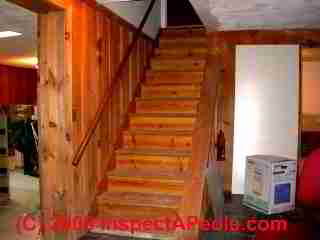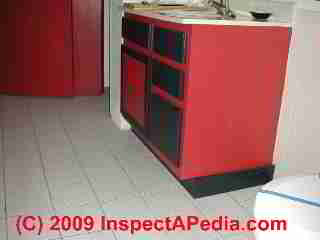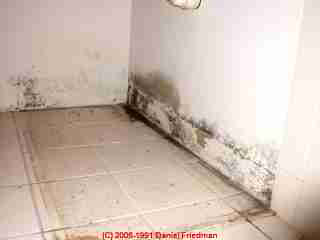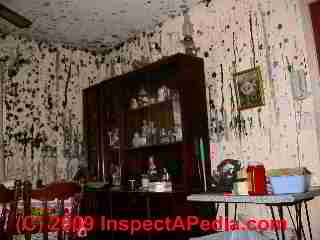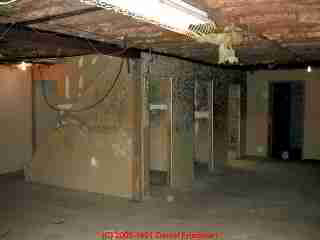 How to Determine Mold Risk Levels in Buildings:
How to Determine Mold Risk Levels in Buildings:
Based on Visual Inspection
- POST a QUESTION or COMMENT about how to assess the risk that a building has a serious mold contamination problem
How to evaluate the risk of mold contamination in a building:
To assist in predicting the chances and degree of mold contamination in buildings, even when extensive mold is not visible, this document describes four levels of risk of existing mold contamination or future mold growth in buildings based on the building history, visual observations, and the materials of construction.
Additional risk factors that need to be considered in deciding if a professional mold/IAQ investigation is warranted must include the health risk or vulnerability of building occupants and the existence of complaints at a building.
InspectAPedia tolerates no conflicts of interest. We have no relationship with advertisers, products, or services discussed at this website.
- Daniel Friedman, Publisher/Editor/Author - See WHO ARE WE?
Characteristics of Buildings or Building Areas at Very-Low Mold Risk: Mold Risk Level 1
[Click to enlarge any image]
To assist making decisions regarding building cleaning where mold is a concern, and considering that quantitative measures of "levels of mold" may be precise but highly inaccurate, and considering that quantitative measures used alone fail to adequately consider the results of a thorough, expert visual inspection, building history, and/or visual evidence of mold risk factors, we have invented four subjective levels of risk of actionable mold contamination.
Our photo (left) shows a wood paneled basement where we found no visible mold and no evidence of a history of water entry inside. Inspecting outside we did not find evidence of roof spillage or surface water runoff against or near the building.
While hidden mold could be present, there were no building related health or air quality complaints, there was no visible evidence of mold or leaks, and no there was no report of building history that justified further more invasive mold inspection and testing.
Level 1 Mold Risk Areas include areas and materials in a building for which there is no evidence of having become wet or exposed to high moisture, where no problematic mold has been detected, or where the materials are generally unfriendly to mold growth, such as clean, un-painted masonry surfaces.
Mold can appear in these areas in the future if building conditions change or a new mold-related event occurs. Where a building is at risk-level 0, invasive inspection and expert mold testing are not required.
Characteristics of Buildings or Building Areas at Low Mold Risk: Mold Risk Level 2
These include areas with the presence of mold-friendly building materials such as drywall and kraft-faced insulation do not appear to have been wet, but they are present in enclosed cavities (such as walls or ceilings) with evidence that nearby building areas have been wet or moldy, exposing the Level 1 areas to high moisture levels.
This category also includes instances where mold-friendly materials have become wet from a single event and where the materials were successfully and completely dried within 24 to 48 hours of becoming wet, leaving no hidden, enclosed cavities unattended.
Our photo (left) shows a bath vanity in a bathroom where there was no visible mold. But the toilet (lower right) had a burst tank that flooded the ceramic tile floor as well as other areas of this home.
Though no mold was visible, we removed the vanity to inspect behind it as part of the building rapid-dry-out procedure in an attempt to avoid a mold problem. The results are shown just below at L3: High Mold Risk.
Mold is not visible and mold has not been detected by expert inspection and sampling. In the absence of mold-related occupant complaints expert inspection and testing are not required.
Characteristics of Buildings or Building Areas at High Mold Risk: Mold Risk Level 3
These include areas with the presence of mold-friendly building materials such as drywall and kraft-faced insulation are wet or have been wet, and these materials remain in place in enclosed cavities (such as walls or ceilings) with no evidence that the cavities were completely dried out within 24 to 48 hours after the wetting event, or with evidence that wetting has been a recurrent event.
Additional inspection and testing may be appropriate and may require use of invasive methods.
Our photo (left) shows moldy drywall found behind a bathroom vanity cabinet that was removed for renovations.
Water from a nearby tub ran across the floor and below this vanity cabinet where, trapped, it led to moldy drywall. It may be appropriate to cut open the drywall to confirm that there is not a larger mold contamination problem in the wall cavity, but the visible mold is less than 30 sq.ft. and is a small do-it-yourself mold cleanup project.
In these wall cavities we did not find additional mold contamination and the cleanup was just a small mold project.
Areas of mold contamination smaller than 30 sq.ft.
of contiguous moldy material can usually be cleaned or removed as an ordinary cleaning project by a homeowner or cleaning service, without requiring expert mold inspection, testing and remediation services. A
lso See HIDDEN MOLD, HOW TO FIND.
Characteristics of Buildings or Building Areas With Actionable Mold Contamination: Mold Risk Level 4
These include areas with the presence of non-cosmetic mold (potentially allergenic, toxic, or pathogenic) has been found in an indoor area.
COSMETIC BLACK MOLD does not require special treatment (unless it has been over-grown with other mold genera/species) and should be identified so as to avoid inappropriate costs.
Areas of mold larger than 30 sq.ft.:
No mold inspection nor testing is required to confirm that the property at left needs professional mold remediation.
However inspection may be needed to define the extent and scope of mold cleanup and to prepare pre-cleanup test samples out of the work area to protect against cross-contamination during the mold remediation project.
Non-cosmetic indoor mold found covering 30 sq.ft. or more of contiguous or effectively-contiguous space means that professional cleaning and possibly professional diagnostic inspection and testing are appropriate.
See MOLD TEST REASONS for a discussion of when mold testing in buildings is appropriate.
Also see HIDDEN MOLD, HOW TO FIND.
Cosmetic molds such as bluestain are of no risk to the
building or its occupants and should be addressed only if it is a cosmetic
concern.
See HARMLESS BLACK MOLD for details.
Expert sampling may suggest that significant problematic mold is present a
t an uncertain level/extent in the building, or mold may not have been detected. Additional inspection and testing are appropriate and may require use of invasive methods.
Supporting Research
- Also see the page endReferences or Citations
- A BRIEF GUIDE to MOLD, MOISTURE, and YOUR HOME, [PDF] U.S. Environmental Protection Agency US EPA - includes basic advice for building owners, occupants, and mold cleanup operations. See http://www.epa.gov/mold/moldguide.htm
- US EPA - MOLD REMEDIATION in SCHOOLS & COMMERCIAL BUILDINGS - - US EPA
- Sedlbauer, Klaus. PREDICTION OF MOULD FUNGUS FORMATION ON THE SURFACE OF AND INSIDE BUILDING COMPONENTS [PDF] Fraunhofer Institute for Building Physics (2001): 75-141.
...
Continue reading at MOLD CLEANUP GUIDE- HOW TO GET RID OF MOLD or select a topic from the closely-related articles below, or see the complete ARTICLE INDEX.
Or see these
Recommended Articles
- MOLD / ENVIRONMENTAL EXPERT, HIRE ? to investigate a building for toxic mold.
- MOLD GROWTH on SURFACES for an index of what mold genera/species are frequently found on various building surfaces and materials.
- MOLD CLEANUP - MISTAKES to AVOID
- MOLD RESISTANT CONSTRUCTION
Suggested citation for this web page
MOLD EXPOSURE RISK LEVELS at InspectApedia.com - online encyclopedia of building & environmental inspection, testing, diagnosis, repair, & problem prevention advice.
Or see this
INDEX to RELATED ARTICLES: ARTICLE INDEX to MOLD CONTAMINATION & REMEDIATION
Or use the SEARCH BOX found below to Ask a Question or Search InspectApedia
Ask a Question or Search InspectApedia
Questions & answers or comments about how to assess the risk that a building has a serious mold contamination problem.
Try the search box just below, or if you prefer, post a question or comment in the Comments box below and we will respond promptly.
Search the InspectApedia website
Note: appearance of your Comment below may be delayed: if your comment contains an image, photograph, web link, or text that looks to the software as if it might be a web link, your posting will appear after it has been approved by a moderator. Apologies for the delay.
Only one image can be added per comment but you can post as many comments, and therefore images, as you like.
You will not receive a notification when a response to your question has been posted.
Please bookmark this page to make it easy for you to check back for our response.
IF above you see "Comment Form is loading comments..." then COMMENT BOX - countable.ca / bawkbox.com IS NOT WORKING.
In any case you are welcome to send an email directly to us at InspectApedia.com at editor@inspectApedia.com
We'll reply to you directly. Please help us help you by noting, in your email, the URL of the InspectApedia page where you wanted to comment.
Citations & References
In addition to any citations in the article above, a full list is available on request.
- ENVIRONMENTAL HEALTH & INVESTIGATION BIBLIOGRAPHY - our technical library on indoor air quality inspection, testing, laboratory procedures, forensic microscopy, etc.
- Adkins and Adkins Dictionary of Roman Religion discusses Robigus, the Roman god of crop protection and the legendary progenitor of wheat rust fungus.
- Kansas State University, department of plant pathology, extension plant pathology web page on wheat rust fungus: see http://www.oznet.ksu.edu/path-ext/factSheets/Wheat/Wheat%20Leaf%20Rust.asp
- US EPA - UNA BREVA GUIA a MOHO / HONGO - en Espanol
- In addition to citations & references found in this article, see the research citations given at the end of the related articles found at our suggested
CONTINUE READING or RECOMMENDED ARTICLES.
- Carson, Dunlop & Associates Ltd., 120 Carlton Street Suite 407, Toronto ON M5A 4K2. Tel: (416) 964-9415 1-800-268-7070 Email: info@carsondunlop.com. Alan Carson is a past president of ASHI, the American Society of Home Inspectors.
Thanks to Alan Carson and Bob Dunlop, for permission for InspectAPedia to use text excerpts from The HOME REFERENCE BOOK - the Encyclopedia of Homes and to use illustrations from The ILLUSTRATED HOME .
Carson Dunlop Associates provides extensive home inspection education and report writing material. In gratitude we provide links to tsome Carson Dunlop Associates products and services.


